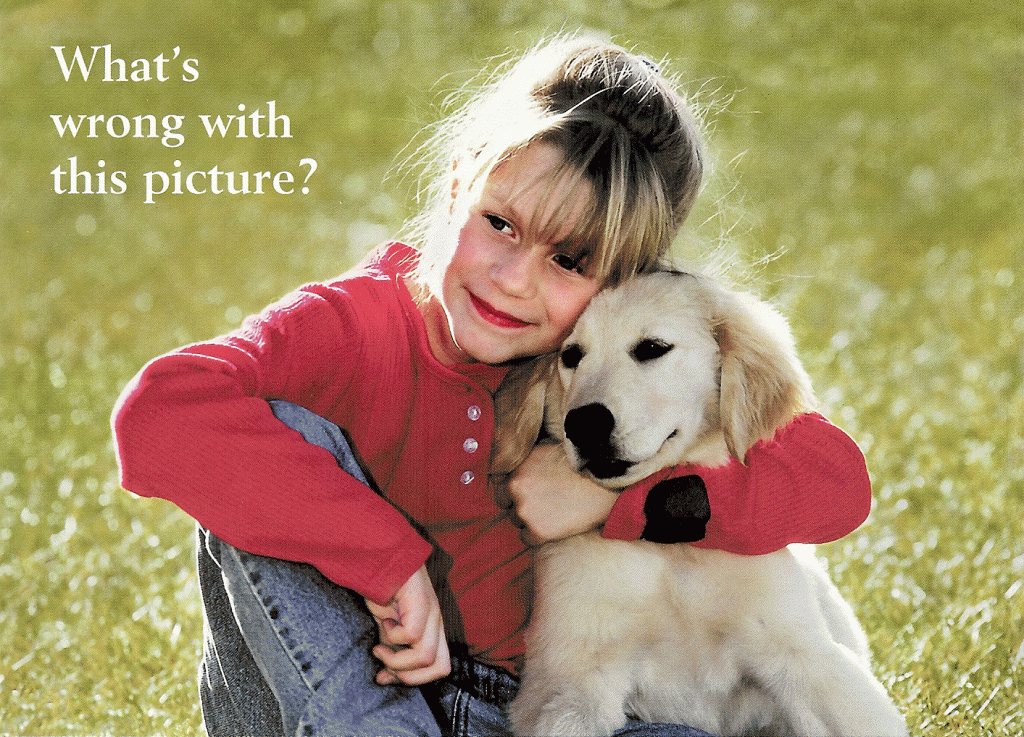
What’s more likely to get you to stop using pesticides on your lawn? Facts about possible impacts of pesticides on streams? Or the idea that you might harm your kids and pets by using pesticides?
When I worked on reducing pesticide use (for the Local Hazardous Waste Management Program in King County), we found that talking about health threats to children was much more effective than talking about water quality. Research shows that people are more motivated to act to protect their kids than to protect the environment.
It’s really not surprising. People have strong feelings about their children and want to protect them. Evoking emotions makes people more likely to act than evoking thoughts.
We created a series of postcards like the one here. We found that people who remembered seeing the postcards were more likely to adopt environmentally friendly gardening practices.
Chip and Dan Heath talk about the power of emotions in “Made to Stick.” They say if you can get people to feel something, they will act differently than if you get them to think something.
How can you evoke an emotional reaction?
Make it personal.
People are more likely to provide money to help one child in Africa than 3 million children. Providing statistics may shift people into a more analytical frame of mind, while telling the story of one child may shift them into a more emotional frame.
Make a connection.
Associate something people don’t yet care about with something they do care about. Jim Thompson, founder of the Positive Coaching Alliance, is working to improve sportsmanship. He’s connecting the individual sport with the larger Game to evoke the idea of honor and respect.
Appeal to self-interest.
“We can make people care by appealing to the things that matter to them,” according to the Heath brothers. When you write or speak, be sure to tell people what’s in it for them. Too often companies or programs talk about features, not benefits. Start with benefits if you want people to pay attention.
Ask people to imagine.
The Heath brothers describe a study that tested two different approaches to tell people about the potential benefits of cable TV.
Approach #1 used lots of facts, such as: Cable TV provides entertainment and information. You can save money by watching TV at home with your family.
Approach #2 asked people to imagine spending time at home with the family watching TV. It used “you” several times in the description to paint a picture of the benefits.
The result? The homeowners who got the informational approach subscribed to cable TV at a rate of 20 percent. Those who “imagined” watching cable TV subscribed at a rate of 47 percent.
Appeal to group identity.
While self-interest matters, people also want to feel connected to a group. Their group identity could be based on race, class, religion, gender, region, political party, industry or many other things.
People may base their decisions or actions on “people like me.” How would they act if they were a southern Baptist? A Buddhist from San Francisco? A hunter from Idaho? A hiker from Seattle? Create messages or tell stories that connect the action you’d like people to take with their group identity.
“Don’t mess with Texas” is a great example of using group identity to change behavior. The target market was tough guys with pick-up trucks (think of someone named Bubba and you get the picture). The campaign aimed to convince Bubba that people like him (that is, real Texans) didn’t litter. The campaign used athletes and musicians that were well known to Texans.
The success of the campaign was astonishing: within a few months, 73 percent of Texans could recall the message as an anti-litter message. Within a year, visible litter had gone down 29 percent. Within five years, visible roadside litter had declined 72 percent.
This post is part of a series of posts about the book Made to Stick by Chip Heath and Dan Heath.
